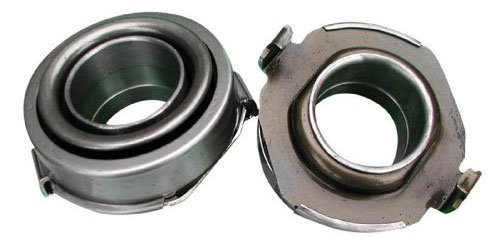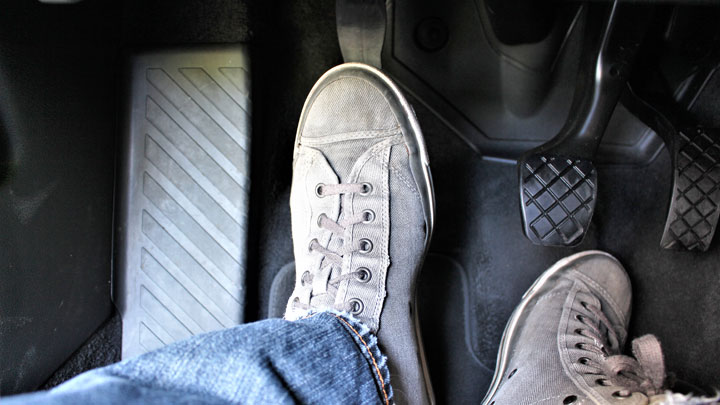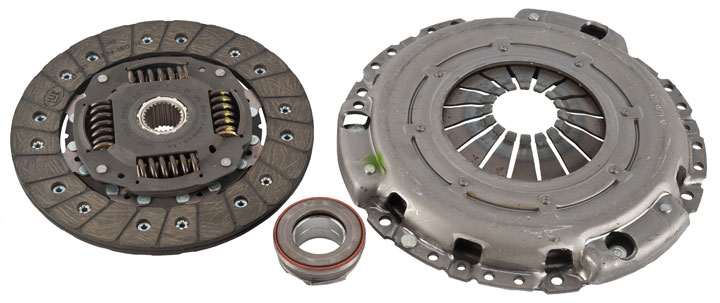If you drive a vehicle with a manual transmission system, you need to operate a clutch pedal in addition to the brake and gas pedals. The clutch assembly (consisting of the pressure plate, clutch plate, flywheel, and throw-out bearing), connects the wheels to the engine of the vehicle. The clutch pedal gives you the ability to temporarily disconnect the wheels from the engine which is needed when shifting gears.
The throw-out bearing, sometimes called a “clutch release bearing”, is a simple yet important component that’s only in use when the clutch pedal is depressed. When you have a bad throw-out bearing, it will affect shifting and can lead to failure of other clutch and transmission components.
How a Throw-Out Bearing Works

In short, a throw-out bearing is the component of the clutch which temporarily disengages a car’s engine from the transmission during gear shifts. When you push the clutch pedal with your foot, the clutch release bearing gets closer to the flywheel.
This causes the release fingers of the pressure plate to get pushed in. Once that happens, the fingers of the pressure plate push against the force of its spring. This causes the disconnect between the engine and wheels and allows you to shift into a different gear.
When the clutch pedal is released, the throw-out bearing returns to its original position where power from the vehicle’s engine once again is transferred through the transmission into the drive wheels of a car.
Common Bad Throw-Out Bearing Symptoms
All the components of the clutch and transmission system are important for the safety and functionality of the vehicle. If your throw-out bearing is unable to do its job properly, you’re going to notice some signs of it starting to go bad or complete failure.
The bearing may go bad after years of wear and tear or maybe even from damage due to an accident. In any case, you need to get the clutch release bearing replaced as soon as you notice it’s having problems.
Below are the top 4 symptoms of a bad clutch release bearing.
#1 – Strange Noises

The most common sign of a bad throw-out bearing is when you hear various noises when you depress the clutch pedal. The rollers within the bearing have a tight tolerance and are supposed to be close together. But if there is too much space between the rollers, then different types of noises will start to be heard. These can include rattling, grinding, squealing, growling, or whirling sounds.
This is simply due to the rollers in the bearing wearing out over time and losing small amounts of material. The noise will sound like it’s coming from the transmission area. The sound will be most noticeable with the clutch pedal fully depressed and go away when you take your foot off the pedal.
#2 – Clutch Pedal Vibrations

When you press down on the clutch pedal, it should move down smoothly. But if you start to feel vibrations coming from the pedal, then it’s very likely that your clutch release bearing is defective or has failed.
More specifically, the vibrations are the result of the throw-out bearing being unable to properly line up with the pressure plate. Your foot will feel pulsations as this happens. The vibrating pedal is similar to how a brake pedal would feel if the disc brakes or brake pads were unevenly worn.
#3 – Gear Shifting Issues

Gear shifts should be smooth without much resistance. If you notice you’re starting to have some difficulty shifting or even grinding gears, it’s possible the throw-out bearing has gone bad. The problem is that your clutch is not fully engaging. This shouldn’t be the first symptom you experience from this problem, though.
You should hear those strange noises first. If you continue to let that issue go unfixed, then you can expect gear shifting issues to follow.
#4 – Clutch is Too Stiff

Like most components of the transmission system, the clutch release bearing is manufactured with special lubrication properties to keep it working smoothly for a long time. Unfortunately, the lubrication properties will wear down as the bearing itself wears down.
The more worn down the bearing is, the harder it will become to depress the clutch pedal. It will soon get to a point where you cannot disengage the clutch. Then you won’t be able to drive your vehicle at all since you won’t be able to shift gears.
Throw-Out Bearing Replacement Cost

Since it is a simple part, a throw-out bearing itself is relatively inexpensive. The problem is the amount of labor it takes to get to it since the entire transmission needs to be removed. It’s usually recommended to also replace the clutch (and sometimes flywheel) while in there.
A throw-out bearing will cost you anywhere from $30-$100. The price of a new clutch can vary greatly depending on the vehicle but most cost somewhere in the range of $300 to $800. A new flywheel (if needed) will set you back another $50 to $200.
As mentioned, labor costs when replacing the throw-out bearing is where you’ll spend the most money. Your mechanic will need 4 to 6 hours to replace the throw-out bearing and clutch so at an average $85/hour labor rate, you’re looking at about $340-$510 just in labor.
All told, the total cost to replace just your throw-out bearing would be $370 to $610. But you will likely want to replace your clutch at the same time so the total replacement cost would be more along the lines of $670 to $1410.
The post 4 Symptoms of a Bad Throw-Out Bearing (& Replacement Cost) appeared first on CarTreatments.com.


















